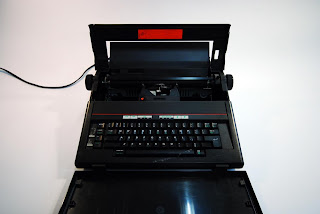Progress. This weekend I spent taking apart my 1987 Brother AX-18 electronic typewriter. I think I got a little too hung up on drawing pieces that really did not reveal anything to me that I could not understand without taking them off. There are a lot of lids and casings to the body that took up my time. In hindsight, I should have spent more time on the guts of the thing. Once I did get through the casing, however, I realized that it is basically made up of 4 components: A power supply. The print-head and chassis. The circuit board. And the keyboard. Here is the progress.
The Brother AX-18 before vivsection.



Keyboard Lid removed. Boring.

Paper Lid removed. It gets more interesting, I promise.


Rear Maintenance Lid removed. Don't give up yet.


Front Maintenance Lid removed.


The Body Casing removed. Finally it starts to really come apart.

Right Platen Knob. Basically this piece (as well as the following left platen knob) turns the paper feed. I know. Pretty obvious, right?

Right Platen Knob. Here you can see the gear, however, which actually interacts with a corresponding gear attached to the print-head chassis.

The half-naked Brother AX-18. Sans top Body Casing.

Here lies the Ink Ribbon Cassette. Basically a little hammer hits the daisy wheel cassette, which in turn contacts the ink ribbon - leaving the impression of the letter on the page. Once again, obvious... I know.

The Daisy Wheel. This slots into the Print-Head and is the source of the letter form. As mentioned, the hammer on the Print-Head contacts the Daisy Wheel. Essentially this is a disc of arms with heads containing reversed letter forms. These are easily replaceable and allow for font changes. This is the advantage of Daisy Wheels over tradition typewriting methods, where you were not able to change fonts necessarily.

The Keyboard half-removed. It took a decent amount of force to actually un-clip this from the bottom tray. It was hanging on for dear life. Here you can clearly see the ribbon circuit which, essentially is the keyboard, connecting to the circuit board. It is a very simple connection. It slots into the circuit board and 2 clips lock it in place.

The Keyboard removed.


The Brother AX-18 sans keyboard.

Here you can see the print-head chassis removed. You can see the ground wire at the back sticking out from the power supply area of the unit. This was really the only thing holding it back, so once that was easily off I was able to splay the unit out further.

A detail of the Print-Head and Chassis. Basically, all the Print-Head is - is a hammer. A really intricate hammer.

Detail of the gear system which operates the paper feed roller.

Detail of the Print-Head.

More to come today. I've got the Circuit Board removed from its clips, and I am ready to begin to really pull the 4 components (power supply, print-head, circuit board, input device / keyboard) out of the bottom tray.








































